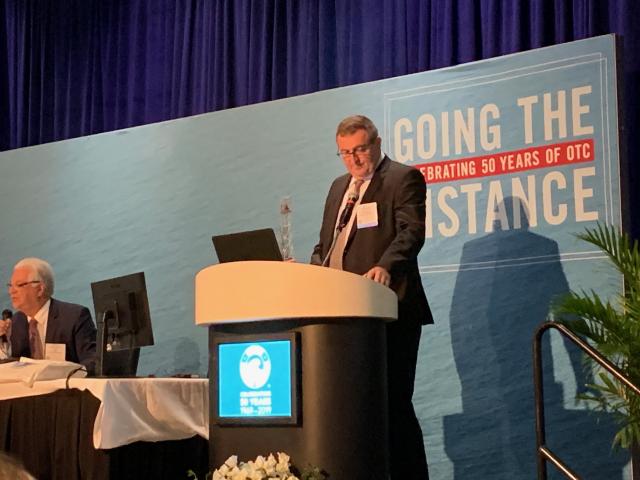
Rudimar Andreis Lorenzatto, Petrobras’ chief technology and production development executive officer, speaks at the Offshore Technology Confeerence in Houston. (Source: Velda Addison, Hart Energy)
For Petrobras, the world’s largest deepwater producer, technology remains on the radar to push forward limits offshore, according to Rudimar Andreis Lorenzatto, the company’s chief technology and production development executive officer.
Digital twins to help optimize production, subsea hi-sep for CO2 and gas separation, safety supervisory systems using intelligent visual analytics, well plugging technology with heat emission to reduce abandonment costs in mature fields and autonomous inspection focused on safety as fewer human divers are used are among the technological targets for the company, he told attendees of the sold-out breakfast session on OTC’s opening day.
“Digital transformation is already happening in people’s lives and in the business world. In Petrobas, we can say it’s a company strategy rather than a technical challenge,” Lorenzatto said. “We have a strong belief that this digital transformation and digital technologies can significantly change our process and activities, bringing more efficiency and improving results.”
But that will happen only if teams are open to change, he added.
Deepwater technology is among the items on Petrobras’ agenda as the company reaches a turning point, having chopped down debt as part of a massive divestment program and continued focus on value creation and efficiency. Other items include building and maintaining a strong exploratory portfolio, focusing on presalt, improving digital transformation efforts and strengthening business partnerships.
“We’ll continue to dedicate our time to make sure that Petrobras will grow and will be better,” Lorenzatto said.
Petrobras, the company behind the closely watched ultradeepwater Libra Field in the Santos Basin offshore Brazil, aims to produce about 1.2 million barrels per day in the presalt area this year and about 1 MMbbl/d from its deepwater assets. Lorenzatto called its breakevens attractive and pointed out Wood Mackenzie analysis showing a less than $40 per barrel breakeven for Brazil deep water and less than $7/boe presalt lifting costs.
“I believe we can unlock higher returns,” Lorenzatto said. “In our project implementation, we have managed costs with good outcomes.”
Using technology, repeatability and scale, the company was able to lower the ramp-up days for presalt projects by 42% in the last seven years, he said. Improvements included, for example, reducing the number of well construction days by 51% in the Buzios Field since 2014.
This came as the company brought more platforms onstream—including seven in the last 11 months—marking a new phase for Petrobras’ upstream segment, he said. The P-68 platform, the first for the Iara area, is nearing completion with entry set for second-half 2019.
Meanwhile, Petrobras—like many others in the E&P business—continues to focus on reducing costs, generating cash and streamlining its portfolio.
As the industry faced unfavorable market conditions and lower oil prices, Petrobras worked to improve its financial health. Between 2014 and 2018, the company’s capex fell by 64% to $13 billion. It divested 35 assets worth about $5.8 billion, which helped enable the company lower its debt.
The effort was supported by three pillars: capex reduction, cost reduction and divestment, Lorenzatto said. “It was hard and painful to make it happen,” he said. “We have to do more with less.”
Petrobras isn’t alone. Amid increased competition, companies are “targeting profitable projects, divesting noncore assets to optimize capex and operating costs in order to obtain better results with fewer resources. It’s tough; it’s challenging. But it brings us good opportunities to improve, to create and to renew,” Lorenzatto said.
Growth remains core to Petrobras’ strategy. The company plans to spend about $69 billion—including $3.5 billion for Libra—while growing annual production by 5% over the next five years. Plans also include bringing 11 new production systems online, including seven in presalt areas, Lorenzatto said.
In addition, Petrobras aims to step up exploration spending following an industrywide slowdown. Lorenzatto said Petrobras’ exploration capex will rise to about $11 billion by 2023. The Campos Basin will see an infusion of about $20 billion in planned capex over the next five years, mainly for projects in areas such as the Marlim and Roncador fields, he said.
Recommended Reading
IOCs See Opportunity in Offshore Mexico, Despite Potential for Policy Changes
2024-08-14 - Five IOCs with offshore experience and capital—Eni, Harbour, Talos, Wintershall Dea and Woodside—continue to pursue promising opportunities offshore Mexico despite the country’s energy sovereignty push in favor of state-owned entities Pemex and CFE.
OPEC Gets Updated Plans From Iraq, Kazakhstan on Overproduction Compensation
2024-08-22 - OPEC and other producers including Russia, known as OPEC+, have implemented a series of output cuts since late 2022 to support the market.
Permian Resources Closes $820MM Bolt-on of Oxy’s Delaware Assets
2024-09-17 - The Permian Resources acquisition includes about 29,500 net acres, 9,900 net royalty acres and average production of 15,000 boe/d from Occidental Petroleum’s assets in Reeves County, Texas.
VAALCO Reports Increased Reserves After Svenska Deal
2024-07-16 - VAALCO acquired Swedish E&P Svenska’s 27.39% non-operated working interest in the deepwater Baobab Field in Block CI-40, offshore Côte d’Ivoire.
Crackin’ It at Kraken: Inside the Bakken’s Ramped-up Private E&P
2024-07-24 - Kayne Anderson-backed Kraken Resources is producing more than 80,000 boe/d today and has a new Fitch Ratings credit score to take to the M&A bank.
Comments
Add new comment
This conversation is moderated according to Hart Energy community rules. Please read the rules before joining the discussion. If you’re experiencing any technical problems, please contact our customer care team.





